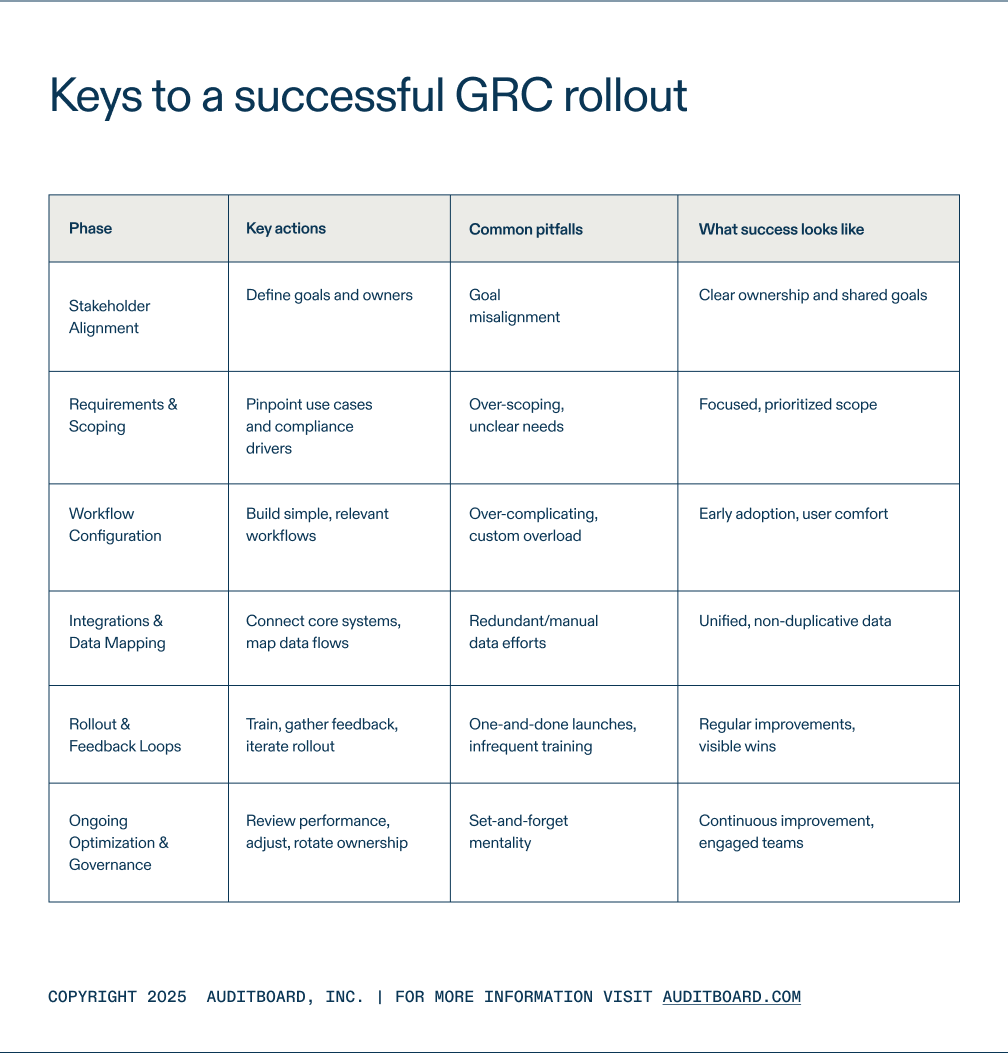
July 18, 2025 • 17 min read
A GRC implementation guide for faster adoption and ROI

Aaron Lancaster
Here’s how most governance, risk, and compliance (GRC) projects start: The energy’s high, the budget’s set, everyone’s ready to toss their old spreadsheets. You launch the kickoff meeting. Then you map out your big wins and imagine a smoother, less stressful life. For a moment, it feels like the heavy lifting is over.
But the reality kicks in fast. Without strategic alignment and process ownership, even well-designed GRC tools get sidelined. Dashboards sit unused, and teams quickly revert to familiar manual workarounds. These stalls happen even to the most committed GRC groups. Some lose momentum early, while others push through but never quite see the return they promised leadership.
These stalls are annoying and expensive. The manual work never really leaves. Visibility stays patchy, and your risk management capabilities suffer. Miss a key milestone or regulatory deadline, and suddenly, the business is paying both in headaches and in real dollars.
Still, some teams do make it work. They see fast adoption and steady value. The trick? It’s not about having more resources or hunting for the “perfect” GRC software. Success comes down to your GRC strategy, who’s involved, which problems get solved first, and how well the workflows match what people do on a busy day.
You can avoid the usual rollout pitfalls by building around your team's real needs, focusing on clear wins, and letting feedback steer your approach. GRC adoption can move quickly and prove its worth if you keep things practical and listen to the people doing the work.
Why GRC implementations stall
Failed GRC rollouts rarely come from bad technology. They trace back to missteps you can see coming (if you know where to look). The most common culprits: fuzzy stakeholder buy-in, too much complexity before anyone’s comfortable, and underestimating the effort it takes to change how your teams work.
If you know why implementations stall, you can spot the warning signs early and correct the course before things go wrong.
Misaligned stakeholders and business objectives
Every GRC platform promises a lot, but adoption crumbles when key stakeholders never agree on what “success” looks like. Maybe IT wants airtight controls for cybersecurity, internal audit teams want faster evidence tracking, or the business side just wants fewer headaches at quarter-end. When these groups talk past each other or get left out, the initiative slows or splinters. Projects end up solving the wrong problem — or none at all.
Clear, up-front alignment around goals, priorities, and who owns what keeps things moving. It’s not a one-time meeting; you need regular check-ins to keep interests aligned as business processes shift. Without this alignment, you miss opportunities for better decision-making across the organization.
Over-complicating the setup before use cases are clear
Ambition is good. But getting lost in complex configuration — before users have handled a single, practical workflow — sets you up for frustration. Loading in every possible control, customizing dashboards, and planning for edge cases before nailing basics can overwhelm your admins and users.
No wonder so many teams end up sticking with what's familiar: 60% of GRC users still manage compliance manually with spreadsheets (even after investing in dedicated platforms).
Projects overload teams with compliance requirements before they've mastered the basics. If nobody can run a risk assessment without help, the fancy automation will gather dust.
A better approach is to start with high-impact, well-understood GRC processes. Let users get comfortable, then build as you learn what actually works for your teams.
Underestimating training and change management needs
GRC projects don’t fail because people don’t care. They fail because nobody taught them how (or why) to embrace the new way. Intro trainings cover the basics, but ongoing support gets left out. Power users end up helping everyone, or worse, nobody asks for help and old habits return.
Unfortunately, this happens more often than not. User adoption across GRC platforms remains stubbornly low, at just 57% overall.
Effective change management means making time for hands-on training, frequent Q&A, and clear channels for feedback. Recognition for early adopters helps too. If you plan for the human side (not just the workflow), your rollout stands a real chance.
The GRC implementation lifecycle: A practical framework
Getting GRC adoption right means working step by step. Each phase builds on the one before. Skip ahead, and you’ll pay for it later. The goal: make sure every move sets your team up for real progress people can see and actually want to keep using.
Aligning stakeholders and business goals
Start by getting the right people in the room. Not just IT or audit. Pull in business leads and control owners — folks who know where the pain points are. Agree on what “better” looks like so everyone stays focused. Document objectives that matter and settle who owns each part of the rollout. Without this? Misalignment drags the project sideways.
A clear roadmap that breaks down implementation phases helps maintain momentum and provides visibility into progress for leadership teams. Set realistic timelines that account for learning curves and competing priorities to keep your implementation on track.
Scoping and requirements gathering
Broad ambitions won’t move you forward, but details will. Pin down the use cases with the highest impact. Which manual process wastes the most time? Where does compliance risk management regularly break down? Build your scope around these pain points.
Figure out which regulatory requirements impact your business first. This clarifies what to tackle right away versus what can wait, so you focus on the most important regulatory compliance issues.
Configuration and workflow design
Now’s when you turn those requirements into a tool your team will want to use. Keep the setup lean at first. Pick workflows that match how real users operate, and streamline operations that cause the most friction. Use out-of-the-box templates if they fit. Testing with small groups pays off here. It’s easier to fix issues before everyone jumps in.
Designing intuitive access control systems at this stage prevents future headaches and allows users to only see the information relevant to their roles.
The goal is to build an effective GRC workflow that improves team productivity.
Integrations and data mapping
If your GRC platform doesn’t talk to existing systems, friction is guaranteed. Identify where data lives and how it should flow. Plan the integrations that matter most. Think risk registers, HR feeds, and incident tracking. Don’t get buried in technical wish lists, just connect what’s necessary so people don’t wind up duplicating effort.
Breaking down information silos through thoughtful integration creates a single source of truth and dramatically improves decision-making capabilities across departments. The right connections boost operational efficiency by eliminating redundant data entry.
Enablement, rollout, and feedback loops
Training isn’t a checkbox. Roll out to a slice of users, watch how they interact, then refine. Make feedback easy with office hours and ongoing Q&A. Celebrate the first wins (and fix early friction before it spreads). Each feedback cycle tightens adoption and shows you’re actually listening.
Track metrics on compliance efforts — who's using what and how often. You'll spot where people need help and show exactly how your GRC work is paying off.
Ongoing optimization and long-term governance
You don’t “finish” GRC implementation. Once live, build in regular checkpoints to review what’s working and where new needs emerge. Tune workflows as priorities shift. Rotate ownership to keep teams invested. Reliable corporate governance ensures GRC keeps pace as risks evolve and regulatory changes happen.
Build continuous improvement into your approach, with regular reviews of how well your GRC framework addresses emerging challenges and vulnerabilities.
A phased, practical approach avoids confusion and burnout. Plan for adoption, not just launch, and you turn your GRC tool from “just another system” into a real business advantage.
Keys to a successful GRC rollout
Every GRC rollout has its own quirks, but a few principles help almost every team get real results. Focus on quick wins and visible improvements. These build trust and keep momentum high.
When you set your foundations this way, adoption happens faster, and the ROI becomes obvious.

Prioritize use cases that deliver early wins
Don’t try to implement everything at once. Choose pain points your users complain about most — something that’s messy, manual, or always causing friction during audit season. Solve those first. For example, digitize quarterly control testing if it wastes too much time, or automate reminders for policy reviews so deadlines stop slipping.
When users see real problems disappear (a.k.a. managing risks gets easier), they start to believe in the platform. Choose use cases that improve regulatory compliance without adding complexity to your users' day. That early buy-in pays dividends when you expand to more complex use cases later.
Build around how teams actually work
Workflows should match your day-to-day reality, not generic best practices. If people collaborate in Slack or Teams, integrate notifications there. Make sure your GRC tasks pop up where your team already lives. Skip complex approval chains unless you really need them. The easier you make it for people to complete their work, the less likely they’ll default to old habits.
Picture your team juggling busy periods and competing projects. Little things, like clear reminders or fewer clicks, make adopting new tools painless instead of a slog.
Enable cross-functional adoption from day one
GRC doesn’t belong to a single department. Bring in finance, HR, security, and compliance leaders early. Assign clear roles and ownership so nothing falls through the cracks. Open up conversations about how each group can use the tool and what support they need.
This cross-team involvement sidesteps finger-pointing and builds a culture where everyone owns their part of risk and compliance.
Get clear on your team's risk appetite early on. This tells you which controls really matter and which ones you can skip, saving everyone from dealing with unnecessary bureaucracy.
Inclusive adoption means fewer blind spots and a platform teams actually want to keep using.
How AuditBoard accelerates GRC implementation
Rolling out a GRC platform is tough. But the right vendor can turn an uphill battle into a fast track. AuditBoard’s approach tackles the most common blockers of compliance management: complex setup and users stuck in the learning curve. Instead of leaving you to figure it out, AuditBoard leans in with expert help and features that fit the way you already work.
Fast configuration with prebuilt templates and frameworks
Speed matters, especially when teams are juggling compliance deadlines. AuditBoard skips the endless blank-slate setup by offering prebuilt templates mapped to industry standards.
You can launch key workflows, like risk assessments or control testing, almost out of the box. If you’re used to wrestling with half-complete configs, this feels like a shortcut you actually want to take.
Dedicated onboarding teams with industry expertise
A lot of vendors toss over generic documentation and call it support. AuditBoard matches you with a team that’s done this before, in your industry. They coach you through challenges and keep the rollout moving when your team hits a snag.
If your group needs extra guidance — say, mapping controls across regions or untangling a gnarly approval flow — they’ve probably solved it before. That experience shows up in fewer delays and a smoother learning curve.
Seamless integrations that minimize manual work
Nobody wants another tool that sits outside the daily workflow. AuditBoard connects with systems you already use (HRIS, ITSM, document management tools) to streamline access reviews, risk register updates, control testing workflows, and audit evidence collection.
You reduce double entry and finally see complete data without piecing it all together. Less manual effort means your team actually keeps the system up to date. No more chasing people at quarter-end.
Change management support that drives adoption
Even the best GRC platforms fail when people don’t use them. AuditBoard’s onboarding includes change management support, not just features and training.
Your team gets practical guidance on how to roll out new workflows, gather feedback, and boost adoption from day one. It’s not just a “go-live” date; it’s hands-on help with the real work of getting people to let go of old habits.
With AuditBoard, you can start with risk mitigation where it hurts most, then build out from there. No need to tackle everything at once — just fix what's burning first, then expand at your own pace.
Want deeper, actionable examples of these principles? See how connecting risk and compliance work across teams can help you build a GRC program that actually delivers. Explore how leading teams use AuditBoard to unify work, drive accountability, and achieve better results.
Make GRC the tool everyone wants to use
Sometimes the biggest shift comes from a single change: A pain point vanishes or an audit request takes minutes instead of hours.
Those are the moments that turn skeptics into advocates. Keep checking in with your team and act quickly when confusion pops up.
Every improvement builds trust, which brings more people on board.
Looking to finally make your GRC program stick? Request a demo and let AuditBoard show you how real progress happens.
About the authors

Aaron Lancaster is a Manager of Partner Solutions at AuditBoard, where he serves as a product and industry expert to support AuditBoard’s alliance members. Aaron has more than 15 years of experience in internal audit, risk management, organizational controls, compliance, and business process improvement with primary focus on financial services. Connect with Aaron on LinkedIn.
You may also like to read


Beyond the compliance checklist: Risk-driven cyber GRC

Connected risk: The AI-driven convergence of audit, risk, and compliance

What to look for in modern IT risk management software

Beyond the compliance checklist: Risk-driven cyber GRC

Connected risk: The AI-driven convergence of audit, risk, and compliance
Discover why industry leaders choose AuditBoard
SCHEDULE A DEMO



